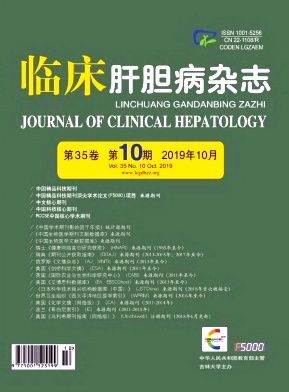|
[1] BRAY F,FERLAY J,SOERJOMATARAM I,et al. Global cancer statistics 2018:GLOBOCAN estimates of incidence and mortality worldwide for 36 cancers in 185 countries[J]. CA Cancer J Clin,2018,68(6):394-424.
|
|
[2] TABRIZIAN P,JIBARA G,SHRAGER B,et al. Recurrence of hepatocellular cancer after resection[J]. Ann Surg,2015,261(5):947-955.
|
|
[3] POON R,FAN S,LO C,et al. Long-term survival and pattern of recurrence after resection of small hepatocellular carcinoma in patients with preserved liver function-Implications for a strategy of salvage transplantation[J]. Ann Surg,2002,235(3):373-382.
|
|
[4] LIAO R,FU YP,WANG T,et al. Metavir and FIB-4 scores are associated with patient prognosis after curative hepatectomy in hepatitis B virus-related hepatocellular carcinoma:A retrospective cohort study at two centers in China[J]. Oncotarget,2017,8(1):1774-1787.
|
|
[5] XIAO Z,YAN Y,ZHOU Q,et al. Development and external validation of prognostic nomograms in hepatocellular carcinoma patients:A population based study[J]. Cancer Manag Res,2019,11:2691-2708.
|
|
[6] PANG Q,ZHOU L,QU K,et al. Validation of inflammationbased prognostic models in patients with hepatitis B-associated hepatocellular carcinoma:A retrospective observational study[J]. Eur J Gastroenterol Hepatol,2018,30(1):60-70.
|
|
[7] CAI BB,SHI KQ,LI P,et al. A nomogram integrating hepatic reserve and tumor characteristics for hepatocellular carcinoma following curative liver resection[J]. Clin Chim Acta,2018,485:187-194.
|
|
[8] YU C,ZHANG Y. Development and validation of a prognostic nomogram for early-onset colon cancer[J]. Biosci Rep,2019,39(6). pii:BSR20181781.
|
|
[9] DENG W,ZHANG W,YANG J,et al. Nomogram to predict overall survival for thoracic esophageal squamous cell carcinoma patients after radical esophagectomy[J]. Ann Surg Oncol,2019,26(9):2890-2898.
|
|
[10] SHI HT,JIANG YQ,CAO HG,et al. Nomogram based on systemic immune-inflammation index to predict overall survival in gastric cancer patients[J]. Dis Markers,2018,2018:1787424.
|
|
[11] MAI RY,YE JZ,WANG YY,et al. Value of albumin-bilirubin score combined with aspartate aminotransferase-to-platelet ratio index in predicting the development of posthepatectomy liver failure in patients with HBV-related hepatocellular carcinoma[J]. J Clin Hepatol,2018,34(2):292-297.(in Chinese)麦荣云,叶甲舟,王言焱,等. ALBI联合APRI对HBV相关肝细胞癌肝切除术后肝衰竭发生的预测价值[J].临床肝胆病杂志,2018,34(2):292-297.
|
|
[12] CHEN W,ZHENG R,BAADE PD,et al. Cancer statistics in China,2015[J]. CA Cancer J Clin,2016,66(2):115-132.
|
|
[13] SHEN J,HE L,LI C,et al. Prognostic nomograms for patients with resectable hepatocelluar carcinoma incorporating systemic inflammation and tumor characteristics[J]. Oncotarget,2016,7(49):80783-80793.
|
|
[14] McGLYNN KA,PETRICK JL,LONDON WT. Global epidemiology of hepatocellular carcinoma[J]. Clin Liver Dis,2015,19(2):223-238.
|
|
[15] HSU CY,LIU PH,HSIA CY,et al. Nomogram of the Barcelona Clinic Liver Cancer system for individual prognostic prediction in hepatocellular carcinoma[J]. Liver Int,2016,36(10):1498-1506.
|
|
[16] ZHANG XP,CHEN ZH,ZHOU TF,et al. A nomogram to predict early postoperative recurrence of hepatocellular carcinoma with portal vein tumour thrombus after R0 liver resection:A large-scale,multicenter study[J]. Eur J Surg Oncol,2019,45(9):1644-1651.
|
|
[17] WANG Y,SUN K,SHEN J,et al. Novel prognostic nomograms based on inflammation-related markers for patients with hepatocellular carcinoma underwent hepatectomy[J].Cancer Res Treat,2019.[Epub ahead of print]
|
|
[18] CILLO U,VITALE A,GRIGOLETTO F,et al. Prospective validation of the Barcelona Clinic Liver Cancer staging system[J]. J Hepatol,2006,44(4):723-731.
|
|
[19] GUGLIELMI A,RUZZENENTE A,PACHERA S,et al. Comparison of seven staging systems in cirrhotic patients with hepatocellular carcinoma in a cohort of patients who underwent radiofrequency ablation with complete response[J]. Am J Gastroenterol,2008,103(3):597-604.
|
|
[20] GRIECO A,POMPILI M,CAMINITI G,et al. Prognostic factors for survival in patients with early-intermediate hepatocellular carcinoma undergoing non-surgical therapy:Comparison of Okuda,CLIP,and BCLC staging systems in a single Italian centre[J]. Gut,2005,54(3):411-418.
|
|
[21] LIAO R,PENG C,LI M,et al. Comparison and validation of the prognostic value of preoperative systemic immune cells in hepatocellular carcinoma after curative hepatectomy[J].Cancer Med,2018,7(4):1170-1182.
|
|
[22] SHIM JH,JUN MJ,HAN S,et al. Prognostic nomograms for prediction of recurrence and survival after curative liver resection for hepatocellular carcinoma[J]. Ann Surg,2015,261(5):939-946.
|














 DownLoad:
DownLoad: